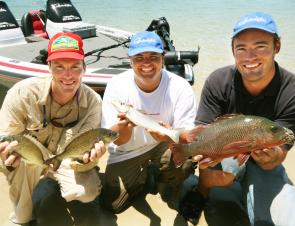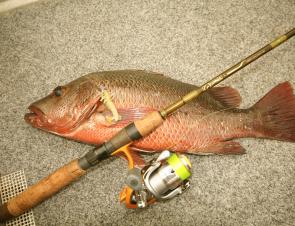This Summer has been memorable with pretty good weather and even better fishing on the Tweed.
The mangrove jack season has been excellent with good numbers of these prized fish caught. Although it has been a fairly costly endeavour in the lure department, it has been great fun targeting them.
If you haven't yet managed to come to grips with the red devil of the Tweed, don't despair: They will still be on the chew in April.
The jacks are still spread out throughout the system and can be found anywhere from the bridge at Murwillumbah to the rock walls at the Tweed Bar.
The secret to catching one is to actively target them and forget about all the other species in the river – something that is extremely hard to do when there are trevally smashing into baitfish a few metres away or bream hammering prawns in the mangroves.
Livies fished down the rock walls or around bridges are the most consistent jack producers. Just remember that a stout rod and a quality reel loaded with fairly heavy line are the most important factors to hooking and landing a mangrove jack.
Casting a large diving minnow that works to around 4m up tight against the same structure and retrieved with a constant, steady wind is also a good technique. Try to remember that these fish are not out in the middle of the day. Although there will always be the odd incidental capture, they are at the their most active in low light and this is by far the best time to target them.
The hot weather should slowly start to lose some of its edge this month and morning sessions might even require the odd jumper to keep the chill out. We sometimes get an early run of large bream through the Tweed in April so don't write them off as targets when heading out.
The Fingal rock wall up as far as the Barneys Point bridge is the pick of the spots to target these fish. Small deep-diving hardbodies like the Smith Dredge or Bassday Sugar Minnow cast up against the wall and worked down the face cover ground quickly.
The start of the run-out tide that coincides with an early morning or late evening is the best time. The morning session is the pick because these larger fish are extremely sensitive to boat traffic.
Fish the rock wall fairly quickly to try to locate active fish. If you catch one good sized fish, try to hit the same spot again because they are usually schooling and you can pin a few more before they shut down. The by-catch of large flatties when doing this is pretty good, too.
The period around Easter is excellent for large trevally in the Tweed with some massive GTs turning up. Don't be surprised if you are heading up the river and see some fish busting up on bait that look more like dolphins. These large fish are extremely tough to subdue in the confines of the river because of all the structure but if they are hooked in open water then be prepared for a long battle before they tire.
Big-eye trevally will still be in large numbers around the bridges, especially at night. We are still having awesome sessions at night on poppers. The big-eyes respond well to a surface lure retrieved fairly quickly as soon as it hits the water.
If you locate a patch of these fish it sometimes pays to wait til you see them surface and start smashing bait before making your cast. This normally results in an instant hook-up or some heart-stopping strikes.
The area behind the hospital should be a good place to start looking for some early tailor. Early morning sessions drifting pillies and casting slugs should see you in with a shout.
The ends of the two walls are also good spots to try if you are land-based. If there is a bit of whitewater on the end of the wall, all the better. Just be careful of the seas at these spots; try to keep an eye on the conditions before venturing out.
The current should gradually start to slow down, bringing some welcome relief for the charter operators and us social fishos after a feed of reefies. At the time of writing the wahoo were still around the Nine Mile and Fidos Reef in good numbers, as well as the odd small black marlin.
As the current starts to slow, the 36-fathom and 50-fathom lines will start to fish well for pearlies, snapper, amberjack and yellowtail kings. Jigging these areas with 300g Chaos or Knife Jigs is an excellent way to get your arms stretched by one of the Seriola family.
If you are heading down the Tweed stop in at Anglers Warehouse for some info on what’s biting where, or call them on 07 5536 3822 .
Reads: 3700

April is a month of variety. Bream, whiting and a chunky jack, all caught in a morning’s lure casting session.

If you haven’t yet managed one of these this Summer, there is still time this month. This 50cm jack was caught on a 3” Atomic Prong soft plastic.




